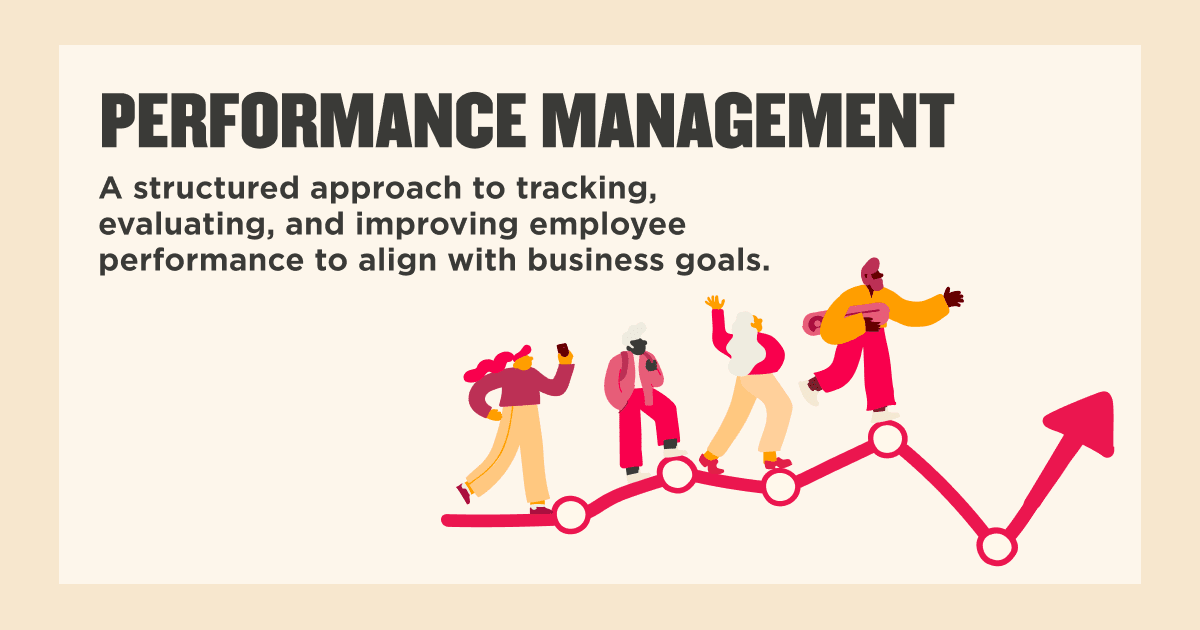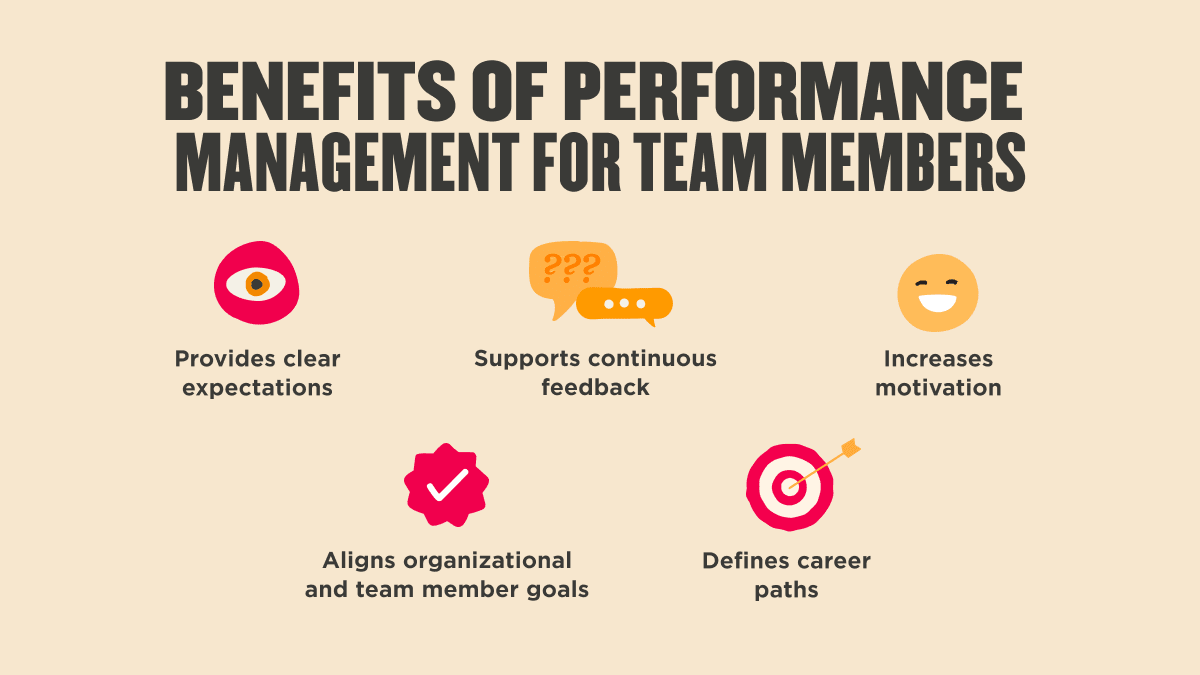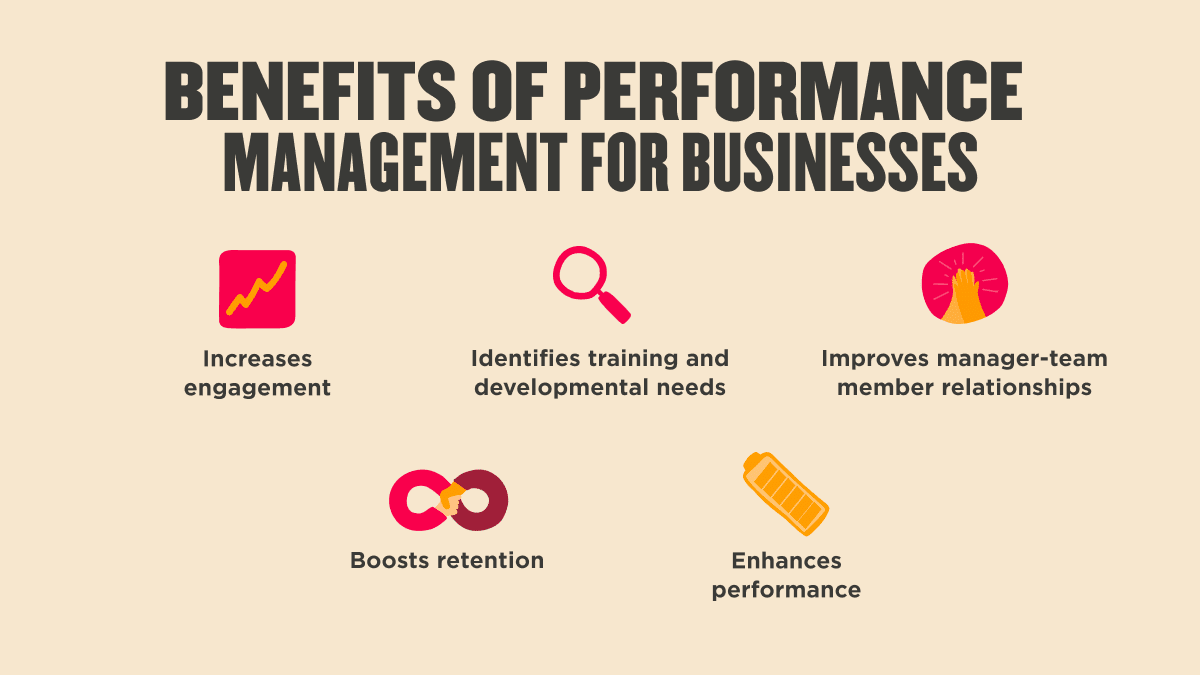Performance management is a structured approach to tracking, evaluating, and improving team member performance to align with business goals.
Performance management is more than just an annual review—it’s a strategic lever for building high-performing, engaged teams. When done well, performance management creates a continuous cycle of feedback and development that helps people thrive and contributes to stronger business outcomes.
Yet while 98 percent of businesses agree that performance management is essential, only 64 percent have a strategy in place. This disconnect presents a real opportunity: To rethink traditional approaches and implement agile, people-first frameworks that reflect modern workplace dynamics. With the right approach, organizations can better support their teams, unlock potential, and build a culture of growth.
<< Use these performance management templates to empower your people. >>

What is performance management?
Performance management is a structured approach to tracking, evaluating, and improving team member performance to align with business goals. The essence of it is equipping people with the resources and feedback they need to succeed. It includes goal setting, regular check-ins, real-time feedback, and meaningful development conversations that support individual growth and team momentum.
For example, a manager might notice one of their team members struggling with communication during team meetings. Instead of waiting for annual feedback, the manager sets up multiple training sessions focused on communication skills and schedules weekly check-ins to provide timely feedback and guidance. Over time, these efforts lead to noticeable improvements in the team member’s communication, enhancing overall team dynamics and productivity.
Key insights
- Performance management is a structured approach to tracking, evaluating, and improving performance to align with business goals
- A strong performance management system includes goal setting, continuous feedback, regular evaluations, and career development opportunities
- Businesses benefit from performance management through higher engagement, improved productivity, better retention, and enhanced manager-team member relationships
- Team members experience clear expectations, ongoing feedback, career growth opportunities, and increased motivation through structured performance evaluations
- Key performance management best practices include using a positive coaching approach, regular check-ins, 360-degree feedback, and tailored development plans
- Tracking performance metrics like work efficiency, revenue per employee, and absenteeism helps businesses refine their performance strategies
- Implementing performance management tools such as LMS platforms, recognition software, and appraisal systems can streamline the process and improve accuracy
What are examples of performance management?
Performance management helps companies support, develop, and recognize their teams. In fact, Anand Dewan asserts that “A good performance management system is as crucial as a good management board of the organization.”
The following examples show how organizations have demonstrated the value of a good performance management system by applying these practices to strengthen culture and drive results.
HSBC
HSBC introduced an app for team members and managers to act quickly on achievements and feedback. Team members use the app to manage HR tasks, track performance plans, and access learning resources. Meanwhile, managers set goals, conduct regular check-ins, and approve actions on-the-go. This tool has strengthened the connection between managers and team members, turning end-of-year reviews into ongoing, meaningful conversations.
Knix
Knix used Bob to facilitate regular feedback and development discussions. Setting clear goals and encouraging open dialogue, they enhanced team collaboration and individual growth, leading to improved performance outcomes.
After introducing structured performance reviews, the company saw a significant boost in cross-department collaboration. Team members felt more connected to the mission and more empowered to own their professional development.
Montu
Montu implemented Bob’s performance management system, with a focus on continuous learning and development. They provided team members with access to tailored training programs and frequent check-ins, creating a culture of improvement and engagement aligned with business objectives.
Managers noted that regular performance conversations made it easier to identify and nurture high-potential talent within the organization. This streamlined approach to performance management and talent development resulted in a 30 percent reduction in turnover within the first year of implementation.
Recommended For Further Reading
Anyfin
Anyfin adopted Bob’s tools to integrate feedback and goal-setting processes. This allowed managers to provide real-time insights and support, boosting team productivity and satisfaction. The company credits this streamlined approach with accelerating their product development cycle by 20 percent. Plus, Anyfin’s leadership team found that transparent performance metrics helped create a more equitable promotion process, strengthening trust throughout the organization.
<<Use this free performance review checklist to optimize your review cycle.>>

Benefits of performance management for team members
Performance management equips team members with the guidance, feedback, and resources they need to perform at their best. Here are some of the ways it makes a difference:
Provides clear expectations
People perform better when they clearly understand the KPIs, metrics, and standards used to measure their work. A strong performance management strategy provides this clarity, helping everyone align their individual goals with the organization’s objectives. This focus leads to more effective teamwork and better overall results.
Supports continuous feedback
According to Forbes, 40 percent of team members disengage when they don’t receive enough feedback. A continuous feedback system through regular performance management helps prevent that by giving managers a way to provide regular, consistent input that keeps people engaged and connected to their goals. Open communication throughout the year allows team members to adjust in real time, rather than waiting for end-of-year reviews.
This transparency also addresses the common concern that only 51 percent of people believe performance reviews are accurate. When feedback happens just once a year, it can feel out of touch with actual contributions. Continuous feedback makes evaluations more accurate and up-to-date, builds trust, and drives stronger results.
Increases motivation
Over 70 percent of people feel more motivated when their manager acknowledges their hard work. Structured performance management creates a culture where feedback and development are part of everyday work, strengthening people’s connection to their roles and boosting morale. Motivated team members, in turn, drive productivity, hit targets more effectively, and stay engaged.
Aligns organizational and team member goals
Through transparent performance management, people see the impact of their work on the company’s success. This gives them a clear sense of direction, showing how their efforts directly contribute to organizational goals.
For example, if the company sets a target of increasing sales by 20 percent, HR leaders can help team members set personal goals—like raising their quarterly sales by five percent—that directly support the bigger objective.
Defines career paths
Career advancement matters to team members, yet only 29 percent feel satisfied with the career paths available at their workplace. Implementing a supportive performance management system can help you actively plan how to advance team members’ skills or transition them to new, better-suited positions.
For example, during a quarterly review, an HR assistant might share their goal of becoming an HR coordinator by year’s end. Their manager can support this by offering training and assigning responsibilities like leading orientations and handling conflict resolution. Managers who develop people for future roles in this way create a pipeline of talent and keep succession planning active across the organization.
<<Download these free career path templates.>>

Benefits of performance management for businesses
When done well, performance management goes beyond evaluations—it strengthens culture, improves results, and drives long-term growth. Here are some of the key benefits it brings to businesses:
Increases engagement
Recognizing accomplishments and offering development opportunities keeps people connected to their work. Gallup research shows that 80 percent of workers who have received meaningful feedback within the past week are fully engaged. A structured performance management process ensures these moments happen consistently, creating a culture where feedback and growth are expected and valued.
Identifies training and developmental needs
Conducting regular performance reviews, gathering feedback, and holding assessment sessions can help HR identify gaps in team members’ skills and knowledge.
When you identify training needs, organize targeted training programs that address the specific skills your team members need to develop. After these training sessions, follow up with your team to assess their progress and offer any additional support they might need.
Research in performance analysis shows that combining quantitative metrics (e.g. productivity, error rates, task completion time) with qualitative feedback yields actionable insights for development. For instance, an organization might notice that multiple team members fall behind on project deadlines. That pattern suggests a widespread need to strengthen time-management or planning skills. In response, HR can roll out focused workshops, coaching, or microlearning modules to help people build that competence.
Improves manager-employee relationships
Trust and transparency build stronger teams. Frequent, two-way check-ins give managers a chance to offer support, and team members space to raise challenges or share progress.
According to ClearCompany, 43 percent of highly engaged employees receive feedback at least once a week. Effective performance management encourages regular check-ins between team members and managers, such as through one-on-one weekly check-ins or biweekly roundups. This consistent interaction deepens these workplace relationships so team members feel comfortable expressing their needs or concerns.
Boosts retention
People stay where they feel appreciated and see opportunities for career growth. In fact, a LinkedIn report found that 94 percent of employees would stay longer at a company that invests in their career development. Businesses that implement a strong performance management system—and pair it with recognition programs—can reduce team member churn.
For example, research shows that businesses that use continuous feedback as part of their performance management strategy retain up to 85 percent of their team members.
When managers recognize contributions consistently and focus on creating a supportive culture, people feel valued and motivated to stay. Recognition reinforces progress, strengthens engagement, and builds morale. Together, these factors help organizations retain skilled professionals who invest in the company’s success while reducing the costs and time spent on hiring, onboarding, and training new team members.
Enhances performance
Performance management helps you identify your team’s skill gaps, provide the right training opportunities, set clear goals, and offer consistent feedback on their progress. This approach collectively boosts performance, leading to tangible benefits for your organization.
Organizations with effective performance management systems are 4.2 times more likely to outperform their peers and see 30 percent higher revenue growth. So by equipping your sales team with a sales enablement platform, for example, or providing targeted coaching, you can empower them to meet higher targets, resulting in increased revenue for your business.
Performance management best practices
HR leaders can use the following performance management best practices to help individuals sharpen their skills and develop their careers:
1. Decide on a performance management framework
Identify a performance management method that addresses your goals and accurately fits the individual positions under evaluation. For example, HR may implement a 360-degree review to gauge personnel development while using management by objectives (MBO) to assess supervisors’ achievements.
2. Take a positive approach
Treating people with goodwill and empathy sets the groundwork for check-ins that can inspire positive growth. Rather than leaving a team member with unhelpful, negative feedback, managers can clarify expectations and coach individuals on how to progress.
3. Train managers
Performance and talent management are about creating structured support to help your people achieve both individual and organizational goals. As Tony Robbins put it, “The best way to motivate people is by setting high standards and then helping them meet those standards.”
Managers play a critical role in providing this support and making performance management effective. The feedback they provide—and the way they deliver it—directly shapes team performance and morale.
Robust training equips managers with skills in communication, emotional intelligence, and coaching, giving them tools to set high standards and support people in meeting them. With this mindset, managers can deliver motivating feedback, recognize achievements consistently, and address challenges constructively.
When managers move from a purely evaluative role to a developmental one, they build trust and turn performance management into a meaningful growth experience for their teams.
5. Track metrics
Consistency and coaching are powerful, but HR leaders also need data to understand how performance management works Tracking the right performance metrics makes it easier to spot trends, identify challenges early, and measure progress over time. Useful metrics include:
- Work efficiency: Measures how well people complete tasks and achieve objectives while maintaining high-quality output.
- Revenue per employee: Shows how much revenue each professional generates in a given period, offering a clearer picture of contribution.
- Errors: Frequent mistakes may signal that someone needs more training or support.
- Absenteeism: High or recurring absence can reveal productivity challenges and affect team performance.
- Overtime: Regularly working beyond standard hours can indicate workload issues or pressure to overachieve, putting people at risk of burnout.
Monitoring these indicators gives HR leaders a balanced view of performance and ensures that support and recognition go where they’re needed most.
6. Use performance management tools
Alongside coaching and measurement, tools can bring structure and scalability to performance management. The right technology helps managers give timely feedback, track goals, and support development at every stage. Common tools include:
- Performance management software: Provides an all-in-one platform to set goals, track progress, run reviews, and connect feedback with recognition and development.
- 360-degree feedback software: Collects feedback from colleagues, managers, and direct reports to provide a well-rounded view of performance.
- Performance appraisal software: Automates evaluations, sets goals, and tracks progress.
- Learning management systems (LMS): Delivers targeted training to help people close skills gaps and grow in their roles.
- Employee recognition software: Makes it easier to acknowledge and reward contributions, strengthening motivation and reinforcing positive behaviors.
Use performance management to improve company culture
Performance management is more than a process—it’s a reflection of how an organization invests in its people. When grounded in trust, clarity, and continuous growth, it becomes a powerful lever for shaping a culture where individuals feel empowered and engaged.
Turning performance conversations into meaningful, forward-looking moments helps create an environment where people grow and businesses thrive—together.
<<Download these free performance review templates to streamline your performance management.>>
Performance management FAQs
How is management by objectives different from performance management?
Management by objectives (MBO) focuses on setting clear, measurable goals—often tied to business outcomes—and tracking whether those goals are achieved. For example, a sales manager and their team might agree on increasing quarterly revenue by 10 percent, then evaluate success at the end of the quarter.
Performance management, by contrast, takes a broader view. Along with goal-setting, it includes regular feedback, coaching, development opportunities, and performance reviews. For instance, that same sales team might have monthly check-ins to discuss progress, receive training to sharpen negotiation skills, and get recognition for milestones along the way.
What are performance appraisals?
Performance appraisals are formal evaluations assessing how well team members meet their objectives. This process provides feedback, highlights strengths, and identifies areas for growth.
What are SMART goals in performance?
SMART goals are specific, measurable, achievable, relevant, and time-bound. They provide clarity and focus, guiding team members toward better performance outcomes.
For example, instead of setting a vague goal like “improve customer service,” a SMART goal would be: “Increase customer satisfaction survey scores from 80 percent to 90 percent over the next six months by implementing a new feedback system and holding monthly training sessions.”
What are the four main performance management processes?
The four main processes are setting objectives, giving continuous feedback, conducting performance reviews, and offering development planning. Together, they create a comprehensive framework for performance enhancement.
What are the different types of performance management?
Performance management includes performance acceleration and performance measurement. Performance acceleration focuses on skill development, while performance measurement assesses goal achievement.
What are the 5 stages of performance management?
The five stages—planning, monitoring, developing, rating, and rewarding—work together to help team members reach their potential and contribute to organizational success:
- Planning: Set clear, aligned goals and expectations
- Monitoring: Track progress through regular check-ins and feedback
- Developing: Provide training, coaching, and growth opportunities
- Rating: Evaluate performance fairly through structured reviews
- Rewarding: Recognize achievements with compensation, promotions, or other incentives
What are the 5 Cs of performance management?
The 5 Cs are clarity, communication, consistency, coaching, and commitment. These elements ensure an effective system that supports growth and success.
What are the 3 Ps of performance management?
The 3 Ps are people, process, and performance. Focusing on these ensures a well-rounded approach to managing and improving contributions.
Performance: Here, the focus is on measuring outcomes against goals and expectations. In practice, this means using metrics, feedback, and reviews to evaluate progress, identify gaps, and ensure that individual contributions stay aligned with team and organizational objectives.
People: In performance management, this means identifying individual strengths and areas for growth, setting expectations, and offering the right mix of coaching, training, and recognition. The “people” element ensures managers don’t just measure outcomes but actively guide professionals to develop skills and advance in their roles.
Process: This refers to the structured methods that make performance management consistent—such as regular check-ins, formal reviews, feedback cycles, and supporting tools like performance management software. Having a defined process prevents performance management from being ad hoc or biased and creates a reliable framework everyone understands.
